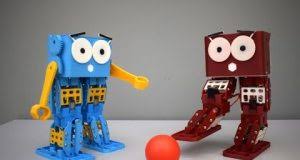 Reading the employee microchip article – does it make you shudder? Observe the development and evolution of modifiers for the word technology. Words like sustainable, appropriate, autonomous all come to mind. With the micro-chipping of employees – the convenience argument is ultra thin. But why would one think about a microchip for an ailing relative, aka an older adult? (Some say we will all get chipped eventually.) Consider that these "chips will offer a convenient way to track people — especially those suffering from Alzheimer’s and dementia." But who will opt in to being chipped and tracked in that example? Employees could opt out – but can a person with dementia opt out? How different is being micro-chipped from wearing a band with identifying address information? For whom is the 'convenience' of micro-chipping offered? And because it is possible, should it be deployed?
Reading the employee microchip article – does it make you shudder? Observe the development and evolution of modifiers for the word technology. Words like sustainable, appropriate, autonomous all come to mind. With the micro-chipping of employees – the convenience argument is ultra thin. But why would one think about a microchip for an ailing relative, aka an older adult? (Some say we will all get chipped eventually.) Consider that these "chips will offer a convenient way to track people — especially those suffering from Alzheimer’s and dementia." But who will opt in to being chipped and tracked in that example? Employees could opt out – but can a person with dementia opt out? How different is being micro-chipped from wearing a band with identifying address information? For whom is the 'convenience' of micro-chipping offered? And because it is possible, should it be deployed?
Because tech can be developed, so it is -- offering 'innovation' we learn to hate… Twenty years ago, computer-generated robo-calls --calls made by a machine, aka ‘predictive dialing’ -- had not reached their adoption tipping point and family members still spoke on the telephone. Could the government help? Well, robo-calling was banned by the FTC in 2009. See how well that worked – Senator Susan Collins did what many do – she disconnected her home phone number, saying as many do – the 'Do Not Call' Registry does not work. So she doesn't have a home phone now – like half of Americans in 2017. Isn’t that sad? But robo-callers don’t care which phone they pester or whether you even answer – they make money just verifying that it is a real phone number and then selling it to someone else.
…Or innovation we will learn to fear. We saw a self-driving car maneuver in traffic in Mountain View, CA. There it went – a real-life videogame --with a driverless vehicle from one of the 19 or more self-driving car companies in Mountain View. Remotely monitored, with a few ignored residents and a researcher or a consumer watchdog group expressing concerns – consider that cities have no power to enact their own restrictions. Euphemistically referring to the reported need during testing for a human to take over as a 'disengagement' report, the technology apparently failed to respond to other drivers on the road. Of course, it would be those unpredictable 'other drivers.' Unlike videogames, where a crash alters the score or ends the game, disengagement is an interesting euphemism for a failure of a design algorithm. Consider the perfect ‘test bed’ of Mountain View – no bad weather, no steep hills, no rotaries or trucks.
…Or technology features that we don’t fear enough. Having one's identity stolen can make a person justifiably paranoid. But by then it is too late. Note that our most important information was made available in the Equifax credit bureau hack which resulted in 147 million possible victims – and consider the number of actual victims in 2017. But we regularly give out just enough information to make it easy to fake or get the rest of what’s needed – so that hackers can steal from us or illegally use our identity for whatever they wish. Giving out our name and birth date on Facebook leads straight to our address, which leads to enough information to get the rest. Given that being hacked has become a fact (or factor) of life, are we immunized from thinking about it, so that we think text verifications to our cell phones are normal, that telling strangers our date of birth and confirming our address is required, no matter which call center we are speaking with?
from Tips For Aging In Place https://www.ageinplacetech.com/blog/just-because-technology-can-be-built-it-acceptable
 As summer winds down, innovators rev up. August is winding down -- the calm before the autumn slew of activity. Nonetheless, new milestones and partnerships were announced this month, including
As summer winds down, innovators rev up. August is winding down -- the calm before the autumn slew of activity. Nonetheless, new milestones and partnerships were announced this month, including  ears ago, when the phone rang, we eagerly picked it up. That was then. For good or ill, families want to text, message and chat. And the phone call has turned into a source of harassment and scams. Robocalling is a modern torment, sometimes multiple back-to-back dials from the same source, often spoofing our
ears ago, when the phone rang, we eagerly picked it up. That was then. For good or ill, families want to text, message and chat. And the phone call has turned into a source of harassment and scams. Robocalling is a modern torment, sometimes multiple back-to-back dials from the same source, often spoofing our  First take – this links together multiple Best Buy initiatives, starting in 2011. Look at the history of Best Buy. First a
First take – this links together multiple Best Buy initiatives, starting in 2011. Look at the history of Best Buy. First a  Voice First technology – triaging the healthcare opportunity. This week’s Voice of Healthcare Summit in Boston offered up some intriguing attempts to create new Voice First interfaces that inform patients, streamline work, and demonstrate potential (like
Voice First technology – triaging the healthcare opportunity. This week’s Voice of Healthcare Summit in Boston offered up some intriguing attempts to create new Voice First interfaces that inform patients, streamline work, and demonstrate potential (like